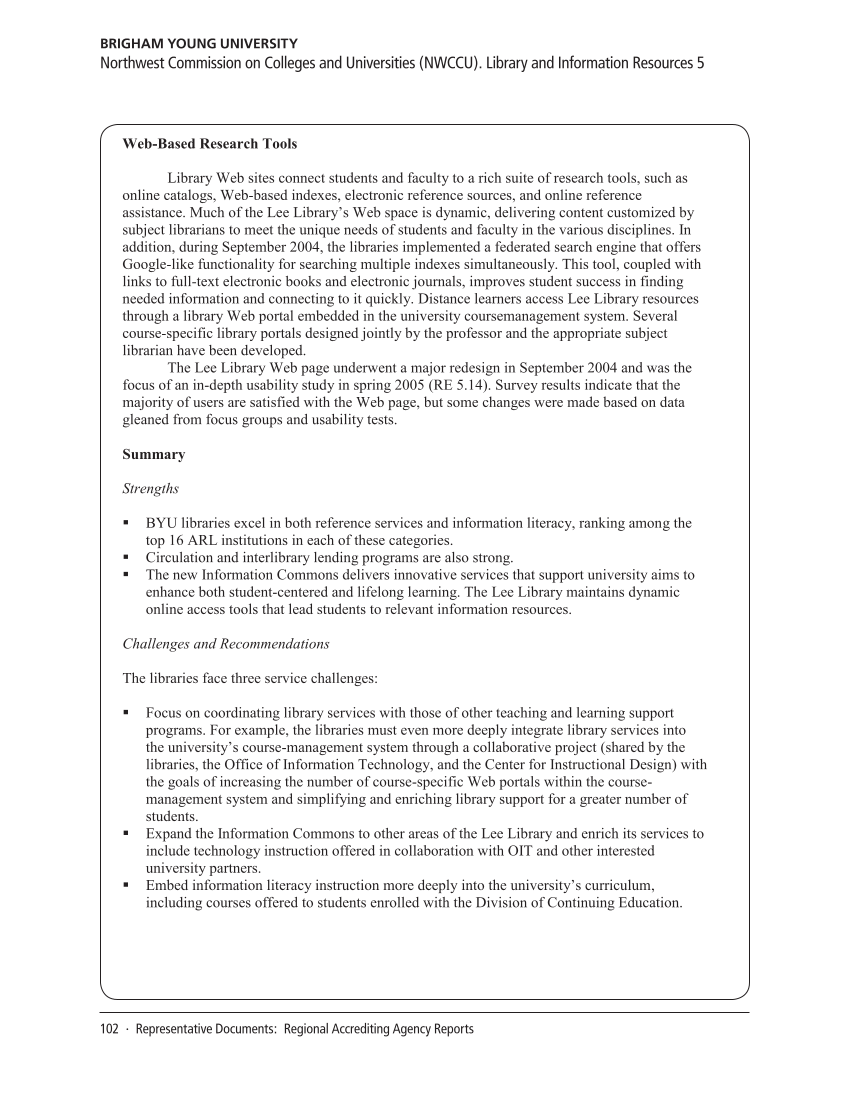102 · Representative Documents: Regional Accrediting Agency Reports
Brigham Young University
Northwest Commission on Colleges and Universities (NWCCU). Library and Information Resources 5
Web-Based Research Tools
Library Web sites connect students and faculty to a rich suite of research tools, such as
online catalogs, Web-based indexes, electronic reference sources, and online reference
assistance. Much of the Lee Library’s Web space is dynamic, delivering content customized by
subject librarians to meet the unique needs of students and faculty in the various disciplines. In
addition, during September 2004, the libraries implemented a federated search engine that offers
Google-like functionality for searching multiple indexes simultaneously. This tool, coupled with
links to full-text electronic books and electronic journals, improves student success in finding
needed information and connecting to it quickly. Distance learners access Lee Library resources
through a library Web portal embedded in the university coursemanagement system. Several
course-specific library portals designed jointly by the professor and the appropriate subject
librarian have been developed.
The Lee Library Web page underwent a major redesign in September 2004 and was the
focus of an in-depth usability study in spring 2005 (RE 5.14). Survey results indicate that the
majority of users are satisfied with the Web page, but some changes were made based on data
gleaned from focus groups and usability tests.
Summary
Strengths
BYU libraries excel in both reference services and information literacy, ranking among the
top 16 ARL institutions in each of these categories.
Circulation and interlibrary lending programs are also strong.
The new Information Commons delivers innovative services that support university aims to
enhance both student-centered and lifelong learning. The Lee Library maintains dynamic
online access tools that lead students to relevant information resources.
Challenges and Recommendations
The libraries face three service challenges:
Focus on coordinating library services with those of other teaching and learning support
programs. For example, the libraries must even more deeply integrate library services into
the university’s course-management system through a collaborative project (shared by the
libraries, the Office of Information Technology, and the Center for Instructional Design) with
the goals of increasing the number of course-specific Web portals within the course-
management system and simplifying and enriching library support for a greater number of
students.
Expand the Information Commons to other areas of the Lee Library and enrich its services to
include technology instruction offered in collaboration with OIT and other interested
university partners.
Embed information literacy instruction more deeply into the university’s curriculum,
including courses offered to students enrolled with the Division of Continuing Education.
Brigham Young University
Northwest Commission on Colleges and Universities (NWCCU). Library and Information Resources 5
Web-Based Research Tools
Library Web sites connect students and faculty to a rich suite of research tools, such as
online catalogs, Web-based indexes, electronic reference sources, and online reference
assistance. Much of the Lee Library’s Web space is dynamic, delivering content customized by
subject librarians to meet the unique needs of students and faculty in the various disciplines. In
addition, during September 2004, the libraries implemented a federated search engine that offers
Google-like functionality for searching multiple indexes simultaneously. This tool, coupled with
links to full-text electronic books and electronic journals, improves student success in finding
needed information and connecting to it quickly. Distance learners access Lee Library resources
through a library Web portal embedded in the university coursemanagement system. Several
course-specific library portals designed jointly by the professor and the appropriate subject
librarian have been developed.
The Lee Library Web page underwent a major redesign in September 2004 and was the
focus of an in-depth usability study in spring 2005 (RE 5.14). Survey results indicate that the
majority of users are satisfied with the Web page, but some changes were made based on data
gleaned from focus groups and usability tests.
Summary
Strengths
BYU libraries excel in both reference services and information literacy, ranking among the
top 16 ARL institutions in each of these categories.
Circulation and interlibrary lending programs are also strong.
The new Information Commons delivers innovative services that support university aims to
enhance both student-centered and lifelong learning. The Lee Library maintains dynamic
online access tools that lead students to relevant information resources.
Challenges and Recommendations
The libraries face three service challenges:
Focus on coordinating library services with those of other teaching and learning support
programs. For example, the libraries must even more deeply integrate library services into
the university’s course-management system through a collaborative project (shared by the
libraries, the Office of Information Technology, and the Center for Instructional Design) with
the goals of increasing the number of course-specific Web portals within the course-
management system and simplifying and enriching library support for a greater number of
students.
Expand the Information Commons to other areas of the Lee Library and enrich its services to
include technology instruction offered in collaboration with OIT and other interested
university partners.
Embed information literacy instruction more deeply into the university’s curriculum,
including courses offered to students enrolled with the Division of Continuing Education.
























































































































































































